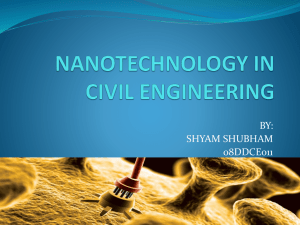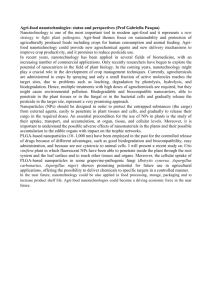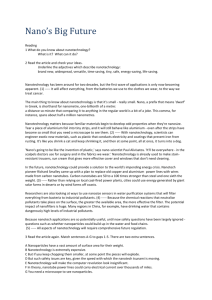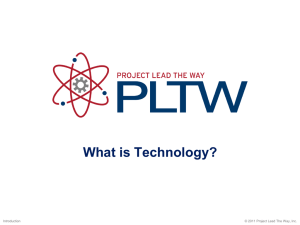Nanotechnology Final Essay
advertisement
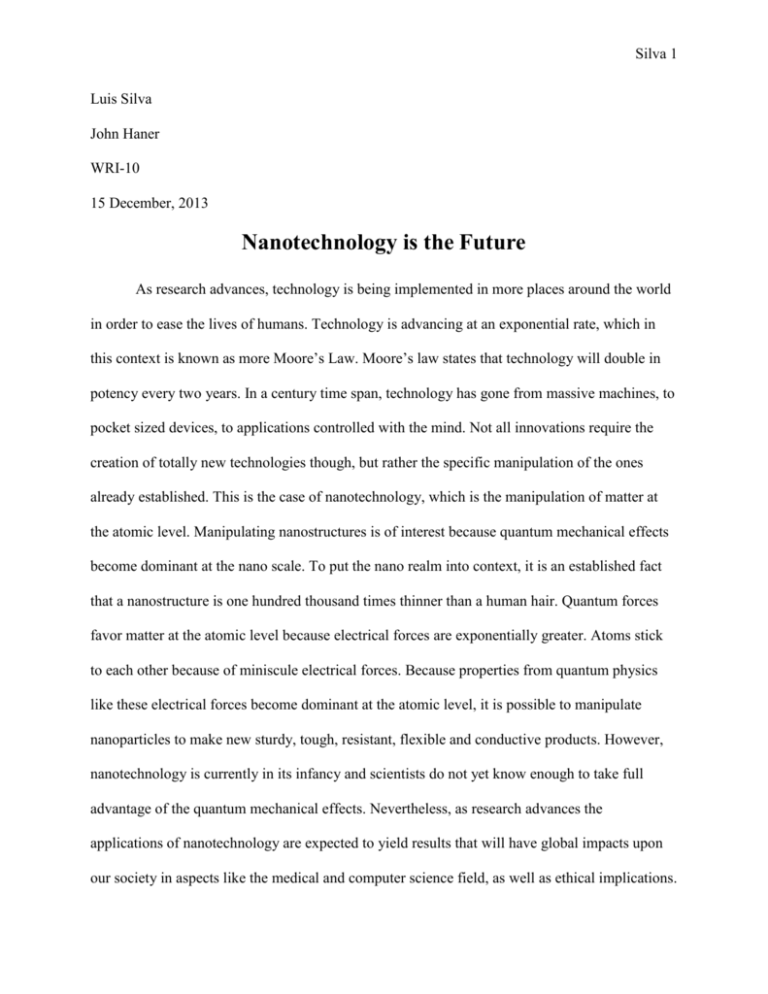
Silva 1 Luis Silva John Haner WRI-10 15 December, 2013 Nanotechnology is the Future As research advances, technology is being implemented in more places around the world in order to ease the lives of humans. Technology is advancing at an exponential rate, which in this context is known as more Moore’s Law. Moore’s law states that technology will double in potency every two years. In a century time span, technology has gone from massive machines, to pocket sized devices, to applications controlled with the mind. Not all innovations require the creation of totally new technologies though, but rather the specific manipulation of the ones already established. This is the case of nanotechnology, which is the manipulation of matter at the atomic level. Manipulating nanostructures is of interest because quantum mechanical effects become dominant at the nano scale. To put the nano realm into context, it is an established fact that a nanostructure is one hundred thousand times thinner than a human hair. Quantum forces favor matter at the atomic level because electrical forces are exponentially greater. Atoms stick to each other because of miniscule electrical forces. Because properties from quantum physics like these electrical forces become dominant at the atomic level, it is possible to manipulate nanoparticles to make new sturdy, tough, resistant, flexible and conductive products. However, nanotechnology is currently in its infancy and scientists do not yet know enough to take full advantage of the quantum mechanical effects. Nevertheless, as research advances the applications of nanotechnology are expected to yield results that will have global impacts upon our society in aspects like the medical and computer science field, as well as ethical implications. Silva 2 Nanomachines Aiding Human Health Applications of nanotechnology in the medical science field include the engineering of a functional nanomachine designed to deliver medicine to a precise location in the body, or to navigate our bodies targeting pathogens, or to perform biopsies at the molecular level. According to the article, Nanomedicine to improve drug delivery outcomes, by the Chronicles of Young Scientists, “The current focus is to move even smaller to produce particles with diameters <500 nm” (259). With a size that is smaller than five hundred nanometers, these molecular robots known as nanobots can either serve as a drug delivery system, a tiny laboratory collecting tissue samples, or can destroy detrimental cells. According to Michio Kaku, a theoretical physics professor at the City University of New York and cofounder of the string field theorem, the state of research being conducted in this medical route of nanotechnology has made these pathogenfighting nanobots a possible reality in a time span of twenty years. The nanobot will excel in precise navigation within the human body because it will be guided by using magnetism to steer it in any direction with a magnet or by “using the tails of ordinary bacteria to propel” it (Kaku 184). A medical application of nanotechnology would consist of sending a nanomachine laboratory into the bloodstream that removes any abnormalities by performing surgery without cutting the skin. For instance, the Anastasia: Essays of Researches article states that the nanobot could “open blocked arteries and treat other cardiovascular diseases” (Singh 3). Nanobots will also be able to continuously monitor the body for detrimental cells such as cancer cells by performing tiny biopsies in search of cancerous tissue. Both of these medical processes would originally require the patient to be cut open during surgery. However, nanotechnology will allow for them to be more efficient and less disturbing to the individual’s everyday life. As Wade Adams, the director of the Smalley Institute for Silva 3 Nanoscale Science and Technology at Rice University, states in his TEDxTalk presentation, once the cancerous cells are found, the nanobots can zap the cells using infrared lights as shown in Figure 1. According to Kaku, 80 percent of the cancerous cells are destroyed using this method. The nanobots will also be able to vibrate next to the cancerous cells and cause them to heat up until their Figure 1. A Creak in the Bloodstream. Photograph by Tim Fonseca http://physicaplus.org.il/zope/home/1223032001/art_de ep_en/zope/sites/physicaplus/home/en/1223032001/art _deep_en/image009.gif/qdisplay_medium.gif cell walls rupture, destroying 90 percent of the cancerous cells as reported by Kaku’s further studies. Using nanomachines to treat cancer will make chemotherapy obsolete because the nanomachines will be able to target cancerous cells and take them out without damaging healthy cells. Whereas, chemotherapy delivers deadly toxins into the body that target both healthy and cancerous cells -- killing cancerous cells faster but causing horrible side effects to the individual. The cancer killing toxins could also be delivered by nanobots that roam freely within the bloodstream. Since blood cells do not have pores, the nanobot containing the drug would simply bounce off the healthy blood cells. In comparison, cancer cells do have pores that will enable “macromolecules, including nanoparticles, to extravasate through these gaps into extravascular spaces and accumulate inside tumor tissues” (Acharya and Sanjeeb 5).This breakthrough in nanotechnology would make the collateral damage from chemotherapy unnecessary. Nanotechnology Making Shapeshifting A Possibility As reported by the “Programmable Matter” article, a group of researchers at Carnegie Mellon University and Intel Research Pittsburgh are jointly participating in a project called Claytronics, in which they are exploring how programmable matter will revolutionize the computer science field. Programmable matter consists of millions of programmable nanobot Silva 4 (claytronic) atoms that can self-assemble into arbitrary three dimensional shapes. With the use of software instructions one can program the claytronic atoms to shapeshift into countless objects, including but not limited to furniture, toys, tools, and a bicycle. According to Tommaso Toffoli and Norman Magolus, researchers at the Massechusetts Institution of Technology Laboratory for Computer Science, “There is the attractive possibility, in the near term, of achieving systems consisting of hundreds of billions of sites, updated a few times per second” (Toffoli and Magolus 9). Kaku agrees with this near term technology statement, as he speculates programmable matter to become a reality somewhere in the midcentury from 2030 to 2070. Figure 2 demonstrates how the claytronic atoms would link together to form the whole programmable matter. Toffoli and Magolus are implying that, in theory, with enough claytronic atoms, one could build entire cities at the push of a button. The uppermost achievement of nanotechnology and Figure 2. Single Nanotube. Photograph by iStock http://www.istockphoto.com/stock-photo13210950-single-nanotube.php engineering is the molecular assembler, otherwise known as the Replicator in the Star Trek television series. The Replicator is a machine that will arrive at the end of the century. It will be able to take in materials as input and manipulate them at the atomic level into any desired object. More precisely, “Trillions upon trillions of nanobots would then converge on the raw materials, each one programmed to take them apart molecule by molecule and then reassemble them into an entirely new product,” says Kaku (200). The technical names of these disintegrating and rebuilding processes are the ‘top-down’ and ‘bottom-up approach.’ According to the Fabrication of novel biomaterials through molecular self-assembly article by Shuguang Zhang, “In the 'topdown' approach, biomaterials are generated by stripping down a complex entity into its Silva 5 component parts (for example, paring a virus particle down to its capsid to form a viral cage). This contrasts with the 'bottom-up' approach, in which materials are assembled molecule by molecule (and in some cases even atom by atom) to produce novel supramolecular architectures” (Zhang 1). It is important to notice that the Replicator branches off the concept of programmable matter because we start with one object and end up with another completely different object. Yet, there is a great difference between the two nanotechnologies that should be recognized. The Replicator takes in non-programmable matter (any raw material) and the machine itself breaks the matter up into its individual atoms to rearrange them into the desired object. Whereas, the programmable matter is itself a computer made up of billions of claytronic atoms that utilizes software instructions to determine its next shape. With these two main processes the Replicator will prove to be the pinnacle of engineering due to its effortless, quick god-like function. Implications of Nanotechnology Aside from the innovative impact in the medical and computer science field, nanotechnology will have global scale implications. The programmable matter technology would replace most labor jobs. There would no longer be any need for the use of tools to build anything when, instead, we can use programmable matter to take the product’s form or throw some old junk into the Replicator to produce it. The engineering field, however, would experience growth in careers because people will still be needed to program the software instructions the claytronic atoms and Replicator will follow. Another benefit of these nanotechnology applications is that garbage production will decline. With every single piece of matter, regardless of it being garbage or raw material, the Replicator will be able to disintegrate it into its most fundamental form, the atom and make it reusable. Unfortunately, the Replicator will not take care of nanowaste. Nanowaste is the waste produced from nanostructures. The current issue is that “nanomaterials Silva 6 have the potential to produce significant sources of nanoparticles into waterways” (Bystrzejewska-Piotrowska, Grazyna, Golimowski and Pawel 6). These nanomaterials will be extremely difficult to filter out due to their size. In addition, programmable matter and Replicator will be able to manufacture anything as long as it is provided with matter to work with, while the nanobots journeying our bodies will be able to destroy cancer from within. This promising statement of course raises quite a few ethical dilemmas. For instance, who gets the privilege to use the replicator? Anything is at your fingertips with such potent technology and so great responsibility is needed. Moreover, what if the nanobots get attacked by the immune system or they assault something other than cancerous cells? These are the types of questions to consider if we want to avoid any drastic consequences. The effects of nanotechnology on people, society and the environment need to be addressed in order for nanotechnology to thrive in the near and long term future. Near Term Effects Nanotechnology unfortunately proposes certain threats to the health of people. Research shows that “titanium dioxide/zinc dioxide nanoparticles from sunscreen contribute to the formation of free radicals in skin cells and in this way damage DNA. This can result in mutations further leading to modifications of the structure and function of proteins. This can also favor tumourigenesis and cancer development” (Piotrowska, Grazyna and Urban 4). Ironically, an application of nanotechnology helps with cancer treatment and even has the potential to replace chemotherapy. Yet, the mass production of nanomaterials can produce enough nanowaste to actually empower the development of cancer among people. It is important to consider whether the potential of each nanotechnology application is valuable enough to outweigh the detrimental effects it can produce. Sunscreen for example, is not the most valuable innovation involving Silva 7 nanotechnology, yet it can cause cancer. Therefore, it would be clever for society to abstain from implementing nanotechnology in sunscreen any longer. This situation exemplifies the types of situations we need to anticipate in the short and long term future before implementing nanotechnology all together. Nanotechnology is currently producing nanowaste. This nanowaste is extremely difficult to filter out from water due to its size. While manipulating nanostructures is of interest because quantum mechanical effects become dominant at the nano scale, the biological and chemical properties differ as well. According to research conducted by Vincent W. Hoyt and Eileen Mason, both faculty of the Occupational Safety and Health department at Murray State University, “Exposure is likely to occur through inhalation, ingestion and skin absorption. No current specific medical evaluation protocols exist for exposure to nanoparticles” (Hoyt and Mason 1). The exposure through skin absorption is of particular interest because it proposes a type of threat for humans that has not historically been very common, since no technology has been able to achieve the size that nanotechnology has. The fact that there are no current protocols to deal with this situation means that the toxicological effects of nanotechnology are poorly understood. Yet, as shown in Figure 1, companies are using nanotechnology more than ever to build their products. Silva 8 Figure 3. The distribution of nanocomponents. Chart by the Nanowerk Nanomaterial Database Inventory (2009) http://ac.els-cdn.com/S0160412010001558/1-s2.0-S0160412010001558main.pdf?_tid=c7271284-5c7f-11e3-902500000aab0f26&acdnat=1386119142_69cf61ccaf71fe9e2e21a1e4bafcc494 Therefore, we ought to reconsider the implementation of nanotechnology knowing it can potentially become a hazard to the health of anyone exposed to water contaminated with nanowaste. Moreover, a study from the Department of Political Science in North Carolina State University claims that the “majority of Americans report low trust in business leaders within the nanotechnology industry to protect them from potential risks” (Macoubrie 6). So apparently the biggest worry for people is not whether companies can implement nanotechnology within safety regulations, but instead if we can trust them to do so. Nanotechnology also proposes a threat to the environment. According to the Isotope Laboratory and the Laboratory of Applied Analytical Chemistry in the University of Warsaw, Silva 9 “exogenous nanoparticles, containing zinc and aluminum, exert toxic effects on germination and growth of roots in the seedlings of six agriculturally relevant plant species. Ryegrass biomass was significantly reduced, root tips shrank, and root epidermal and cortical cells were highly vacuolated or collapsed, as an effect of adherence of ZnO nanoparticles” (Piotrowska, Grazyna and Urban 4). Even though the size of nanotechnology may work to our advantage in the treatment of diseases, it is detrimental to our environment. The contamination has already begun and it will be extremely difficult to clean due to the tiny scale of the nanowaste. Our ability to manage nanowaste will also determine whether or not marine life is affected in the near term future. Results from the collaborative research between the University of California Merced and the Texas A and M University, demonstrated “how nanowaste (e.g. nanoparticles) can potentially disturb the marine carbon cycle and ecosystem” (Chen and Chi-Shuo 1). While this is another venue from which nanowaste can affect us because humans eat marine animals, it is more importantly an issue that affects marine life, which for many is equally important to the life of a human. This suggests that urgent attention to the regulation of nanowaste is needed. Long Term Effects The consistent application of nanotechnology will introduce effects on the world economy in the long term future. After a few decades Moore’s Law will cause the prices to decrease because it states that technology will double in potency every two years. So eventually nanotechnology will become accessible to the middle-class public. Since anything is at an individual’s reach with such a potent, god-like, technology, money will not be needed to obtain material things anymore. How will society work when the Replicator and programmable matter make money obsolete? Ever since the dawn of civilization, and more than ever during the recent Industrial Revolution, humans have dedicated their time and work to the production of all sorts of materials. Yet, with Silva 10 the Replicator this labor is no longer needed. Therefore, nanotechnology will provide a new direction for society. Perhaps we will begin to focus more on expanding to other planets and building civilizations there. In several centuries nanotechnology will be readily available and as a result from the Replicator there will no longer be a gap between social classes in terms of owning material things. How will we distinguish the lower class from the middle class and from the wealthy class? Whether or not this is a good or a bad consequence, there are no laws ready to operate in this form of society. If the current hierarchical structure of social classes crumbles, a new form of government will have to be established altogether. Dealing with Nanowaste The establishment of protocols to manage nanowaste is the first major issue that society will have to solve in order for nanotechnology to work well in our society. In an attempt to achieve a balance between the success of these innovative applications and addressing ethical concerns, a protocol to deal with the nanowaste that the lifecycle of the product produces, and a protocol to empower social corporate responsibility is needed. Since nanotechnology is already being implemented in numerous products, the advancement of research on nanowaste could not be any more urgent. According to Public Policy and Regulation research held at Monash University, the commercialization of nanotechnology has begun in Australia, Japan, the United States and the United Kingdom. However, “As yet, none of the four countries have enacted nano-specific regulations despite the RS-RAE [(Royal Society and Royal Academy of Engineering)] having noted the existence of a gap within the United Kingdom’s regulatory framework for chemicals due to the failure of regulations to evaluate size-dependent risks of ‘existing’ chemicals” (Bowman and Hodge 17). Many of the intrinsic quantum properties of Silva 11 nanoparticles are not taken into account. For example, there is no law that stops nanomaterials from being used in lotion products, thus anticipating the skin absorption of nanoparticles. However, this is definitely possible due to their size. Scientists are not yet familiar with the effects of nanoparticles. Thus, I propose the establishment of a law that would require companies to use a percentage of their funds to test for nanowaste. Musee, who is part of the National Resources and Environment department in Pretoria, South Africa, states in his article that the “available data and knowledge are insufficient to outline the general requirements for the identification of candidate streams meriting treatment before release into the environment,” (Musee 10). If research does not advance in this direction, then regulations cannot be established to monitor the effects of nanotechnology. Hence, it is possible that certain effects will go unnoticed, and, therefore, the global impact of these effects cannot be anticipated and prevented. While the profits the use of nanotechnology yields can be of most interest to the companies utilizing them, it is vital to make them realize the safety of the public is much more important. Musee also addresses this by stating that “to date no single study on the treatment of NMs from commercial and industrial sources has been reported in the scientific literature. This implies a high possibility of the current WWTP [(waste water treatment plants)] allowing considerable volumes of NMs into the aquatic and terrestrial (e.g through irrigation) environmental compartments” (Musee 14).A law requiring corporations to fund nanowaste testing methods would alleviate the advantage the commercialization of nanotechnology has over the research of nanotechnology. Encouraging Responsibility Among Corporations Once the research specific to nanotechnology effects is well on its way and enough data is available to conduct the establishment of laws, the next step is to have industries abide to self- Silva 12 regulation practices in order to comply with these laws. Although staying on the edge of technology may be everything necessary to maximize profits for these corporations, it is often not the venue to address ethical dilemmas like the ones nanotechnology presents. According to scientists in Cardiff University, corporations will have to take a step further and explore “collaborative solutions with other players in the nanotechnology value chain, to create solutions and codes of practice, especially in cases where the ability of firms to respond in an individual capacity is limited due to cost or complexity considerations” (Lee and P.D. 1). Implementing corporate social responsibility will cost a large amount of money, but this teamwork will demonstrate self-regulation practices and thus ensure the safety of the people, as well as their support. Information campaigns are a favorable way of doing so. AT&T is a perfect example of a company that promotes its product while informing the public about the dangers their product can bring forth, such as texting while driving. Their commercial “Texting and Driving, It Can Wait” educates the public at the cost of a large amount of money from their part. However, AT&T is displaying social responsibility with these commercials and showing that they care more about customers than their profits. Corporations involved in nanotechnology should do the same if they plan of succeeding in both the financial and environmentally friendly route. This responsibility among corporations can be established by requiring them to treat nanowaste as hazardous waste to avoid contamination in water sources. In addition, warning labels should also be mandated by law in order to make the public aware that their products might contribute to the production of nanowaste. The authors of the “Nanotechnology for Telecommunications” book state, “The city of Berkeley, California, amended its hazardous materials laws in 2006 to require nanotechnology researchers and manufacturers to report the nanomaterials with which they are working and how they are handling those materials, a move Silva 13 that is expected to draw international attention” (Salinas and Fidel M. 56). Cities should mimic Berkeley and institute similar laws in order to speed up the caution process being taken against nanowaste. Conclusion Nanotechnology is a promising technology that will open the way into the society of the future. Although some of the applications discussed seem like they belong in another time era, they are not so distant. Again, Moore’s Law will increase the rate of nanotechnology development. The basic principles behind nanotechnology are currently being established. The first step into developing these nanotechnology applications is fully comprehending the quantum behavior of atoms. In a few decades, as a result of Moore’s Law, nanotechnology will be everywhere; in our homes, bodies, and in everything made by the Replicator -- which can theoretically make anything. However, as exemplified, several studies are also exposing the detrimental effects nanotechnology will have on people, society, and the environment, which must not be overlooked. Since these effects are proven by concrete data, it is now up to humans to consider what the ethically right thing to do is. The laws that were proposed are aimed to ease this process. By working together with researchers of nanotechnology and product manufacturers, the world can achieve a future dominated, but not entirely burdened by nanotechnology. Then, nanotechnology is, indeed, the future. Silva 14 Works Cited AT&T. “Texting and Driving, It Can Wait – AT&T Commercial.” Online video clip. Youtube. Youtube, 2 Jul. 2012. Web. 7 Dec. 2013. Bowman, Diana M., and Graeme Hodge. "A small matter of regulation: An international review of nanotechnology regulation." Columbia Sci Technol Law Rev 8 (2007): 1-32. Bystrzejewska-Piotrowska, Grazyna, Jerzy Golimowski, and Pawel L. Urban. "Nanoparticles: their potential toxicity, waste and environmental management."Waste Management 29.9 (2009): 2587-2595. Chen, Chi-Shuo, et al. "Effects of engineered nanoparticles on the assembly of exopolymeric substances from phytoplankton." PloS one 6.7 (2011): e21865. Goldstein, Seth Copen, Jason D. Campbell, and Todd C. Mowry. "Programmable matter." Computer 38.6 (2005): 99-101. Hoyt, Vincent W., and Eileen Mason. "Nanotechnology: emerging health issues." Journal of Chemical Health and Safety 15.2 (2008): 10-15. Kaku, Michio. Physics of the Future: How Science Will Shape Human Destiny and Our Daily Lives by the Year 2100. New York: Doubleday, 2011. Print. Lee, Robert, and P. D. Jose. "Self-interest, self-restraint and corporate responsibility for nanotechnologies: Emerging dilemmas for modern managers."Technology Analysis & Strategic Management 20.1 (2008): 113-125. Macoubrie, Jane. "Public perceptions about nanotechnology: Risks, benefits and trust." Journal of Nanoparticle Research 6.4 (2004): 395-405. Misra, Ranjita, Sarbari Acharya, and Sanjeeb K. Sahoo. "Cancer nanotechnology: application of nanotechnology in cancer therapy." Drug Discovery Today 15.19 (2010): 842-850. Silva 15 Musee, N. "Nanowastes and the environment: Potential new waste management paradigm." Environment international 37.1 (2011): 112-128. "Nanomedicine to improve drug delivery outcomes." Chronicles of young scientists 3.4 (2012):258-. Salinas, Fidel M., et al. "Impact of Nanotechnology on Telecommunications." Sohail Anwar M. Yasin Akhtar Raja Salahuddin Qazi (2001): 23. Singh S, Singh A. Current status of nanomedicine and nanosurgery. Anesth Essay Res 2013;7:237-42. TEDxTalks. “TEDxHouston 2011 – Wade Adams –Nanotechnology and Energy” Online video clip. Youtube. Youtube, 06 Aug. 2011. Web. 31 Oct. 2011. Toffoli, Tommaso, and Norman Margolus. "Programmable matter: concepts and realization." Physica D: Nonlinear Phenomena 47.1 (1991): 263-272. Zhang, Shuguang. "Fabrication of novel biomaterials through molecular self-assembly." Nature biotechnology 21.10 (2003): 1171-1178.



